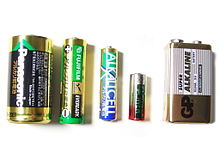Alkaline battery

From left to right: C, AA, AAA, N, and 9V alkaline batteries
|
|
| Self-discharge rate | <0.3%/month |
|---|---|
| Time durability | 5–10 years |
| Nominal cell voltage | 1.5 V |
Alkaline batteries (IEC code: L) are a type of primary battery dependent upon the reaction between zinc and manganese dioxide (Zn/MnO2). A rechargeable alkaline battery allows reuse of specially designed cells.
Compared with zinc-carbon batteries of the Leclanché or zinc chloride types, alkaline batteries have a higher energy density and longer shelf-life, with the same voltage.
The alkaline battery gets its name because it has an alkaline electrolyte of potassium hydroxide, instead of the acidic ammonium chloride or zinc chloride electrolyte of the zinc-carbon batteries. Other battery systems also use alkaline electrolytes, but they use different active materials for the electrodes.
Alkaline batteries account for 80% of manufactured batteries in the US and over 10 billion individual units produced worldwide. In Japan alkaline batteries account for 46% of all primary battery sales. In Switzerland alkaline batteries account for 68%, in the UK 60% and in the EU 47% of all battery sales including secondary types.
Alkaline batteries are used in many household items such as MP3 players, CD players, digital cameras, pagers, toys, lights, and radios, to name a few.
Batteries with alkaline (rather than acid) electrolyte were first developed by Waldemar Jungner in 1899, and, working independently, Thomas Edison in 1901. The modern alkaline dry battery using the zinc/manganese dioxide chemistry was invented by Canadian engineer Lewis Urry in the 1950s while working for Union Carbide's Eveready Battery division in Cleveland, OH, building on earlier work by Edison. On October 9, 1957, Urry, Karl Kordesch, and P.A. Marsal filed US patent (2,960,558) for the alkaline battery. It was granted in 1960 and was assigned to the Union Carbide Corporation.
...
Wikipedia
